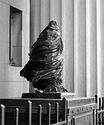I might submit that if you are getting the results you desire, then you're not overexposing or overdeveloping...
I "overexpose" 320 Tri-X by a stop or more intentionally at times just to move the shadows up further onto the straight-line portion of the curve. I'll also "overexpose" in tricky situations when I'm not sure of the shadows, just to be sure to get detail in the lowest values. You'll notice that "overexpose" is in quotes here... I don't really think giving more generous exposure for a good reason is "overexposing." Rather, it is using the tools you have in the best way to ensure you get the image you want.
If one brackets exposures, giving sequentially more exposure for each negative, the quality of the prints made from those negatives (in order from under- to overexposed) will increase until "optimum exposure" is reached (defined as minimum exposure to make the best print) and then level off. Then, prints made from negatives given more exposure will vary only slightly, usually showing only a small increase in graininess, till gross overexposure pushes the highlights up onto the shoulder of the film and highlight separation starts to suffer. Modern films have a lot of latitude between the optimum point and the point where highlight separation starts to suffer. I've made great prints from negatives that proper proof blank white.
In an ideal world, we would all be able to figure out that optimum exposure. However, using overexposure as a bit of insurance is a fine way to deal with tricky subjects (or even to make up for haphazard metering, unreliable shutters, etc.) and insure good shadow detail. Overexposure also gets shadows up higher on the characteristic curve, which increases shadow separation with films with longer toes. Giving more exposure in this case is a technique to get better shadow separation, not overexposure.
As for "overdeveloping": If you're getting the contrast you want, you're not overdeveloping either. I note that the vast majority of images posted here as "overdeveloped" are low-contrast subjects in even, flat lighting. Zone System users have been "overdeveloping" in this situation for decades; they call it N+1, N+2, etc. Don't try this in harsh, contrasty sunlight, however, or you'll be disappointed.
My take on the whole "overexpose and overdevelop" thing is that: 1. giving more exposure usually doesn't hurt any and often helps, especially for those that don't meter correctly for whatever reason. The only penalty is a bit of extra grain; the advantage is a lot better shadow detail. And, 2. giving more development is great for a wide range of subjects, especially those in flat light, especially for those who don't determine their optimum development times by testing. More contrast in the negative can be fairly easily compensated for with modern VC papers (and scanning), so, unless the contrast range is really harsh, this will work well.
Nevertheless, this is really just a less-accurate, down-and-dirty way to get more consistent results. Better metering techniques, development schemes and a good knowledge of your materials and how they respond to different exposures and developments is really far better IM-HO.
Best,
Doremus
 Minolta SR-M #11 by Nokton48, on Flickr
Minolta SR-M #11 by Nokton48, on Flickr





 Minolta XK #6
Minolta XK #6 Makiflex Acros 150 SymmarS
Makiflex Acros 150 SymmarS Minolta XK #9
Minolta XK #9
